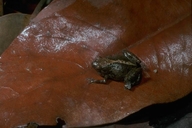|
Distribution and Habitat
Country distribution from AmphibiaWeb's database: Australia
Confined to the area between Cairns and Ingham, north-eastern Queensland.
The area of occurrence of the species is approximately 8400 km2.
Life History, Abundance, Activity, and Special Behaviors
Rainforest. Calls from sticks, logs, standing vegetation and debris on forest floor. Terrestrial
egg deposition – lays 8 to 13 eggs in a connected string in a moist situation away from water.
Entire development within egg membrane.
Trends and Threats
No known population reductions, relatively large area of occupancy and population size.
Threats
Occurs in National Parks in the Wet Tropics. Threats are mainly from human impacts on the
parks, for example: erosion following human traffic, increased visitation, habitat degradation and
development of walking tracks and other tourist facilities.
Conservation Measures
Protected within National Park, but management required for the mitigation of impacts resulting
from tourism.
References
Barker, J., Grigg, G. C., and Tyler, M. J. (1995). A Field Guide to Australian Frogs. Surrey Beatty and Sons, New South Wales.
McDonald, K.R. (1992). Distribution Patterns and Conservation Status of North Queensland Rainforest Frogs. Conservation Technical Report No. 1. Department of Environment and Heritage, Queensland.
Zweifel, R.G. (1985). ''Australian frogs of the family Microhylidae.'' Bulletin of the American Museum of Natural History, 182, 265-388.
Originally submitted by: Jean-Marc Hero et. al. (first posted 2002-04-05)
Edited by: Ambika Sopory, Jean-Marc Hero (2008-09-16)Species Account Citation: AmphibiaWeb 2008 Cophixalus infacetus: Inelegant Frog <https://amphibiaweb.org/species/2254> University of California, Berkeley, CA, USA. Accessed Jan 2, 2025.
Feedback or comments about this page.
Citation: AmphibiaWeb. 2025. <https://amphibiaweb.org> University of California, Berkeley, CA, USA. Accessed 2 Jan 2025.
AmphibiaWeb's policy on data use.
| 